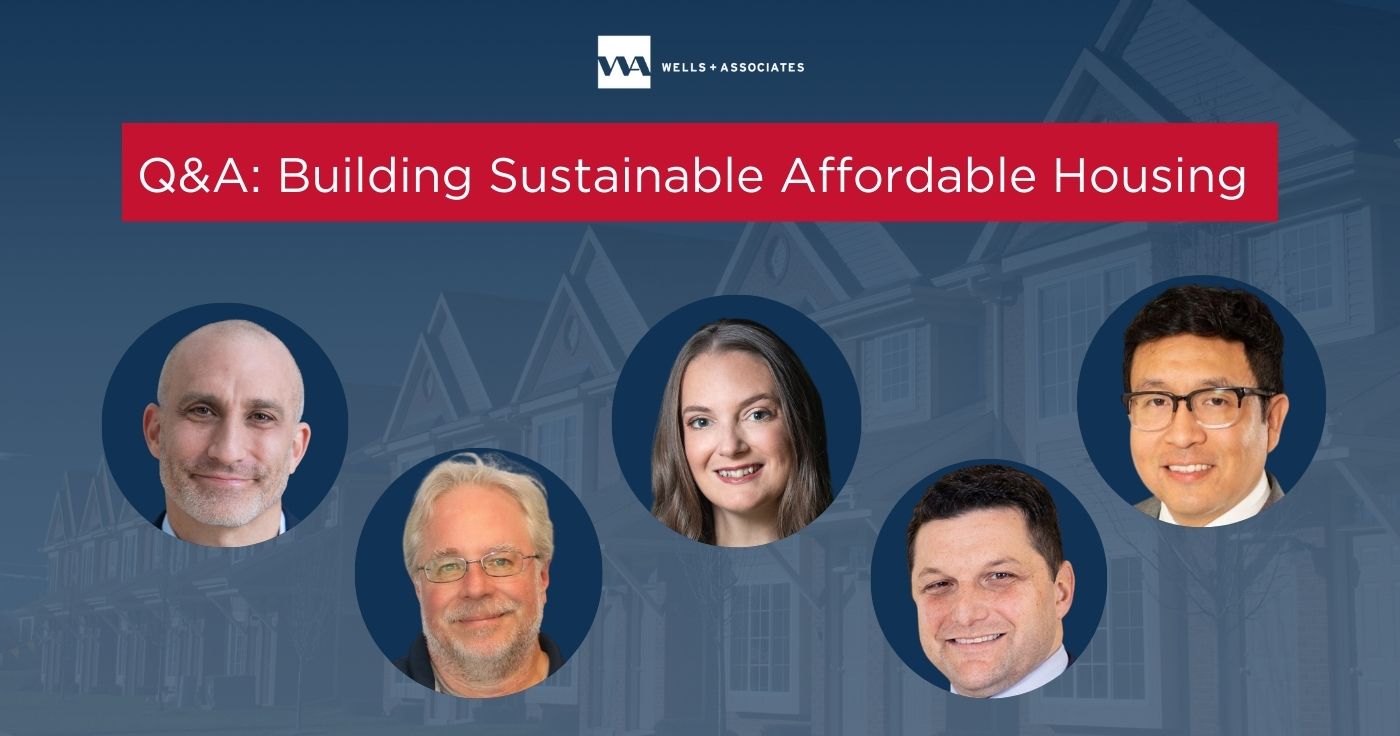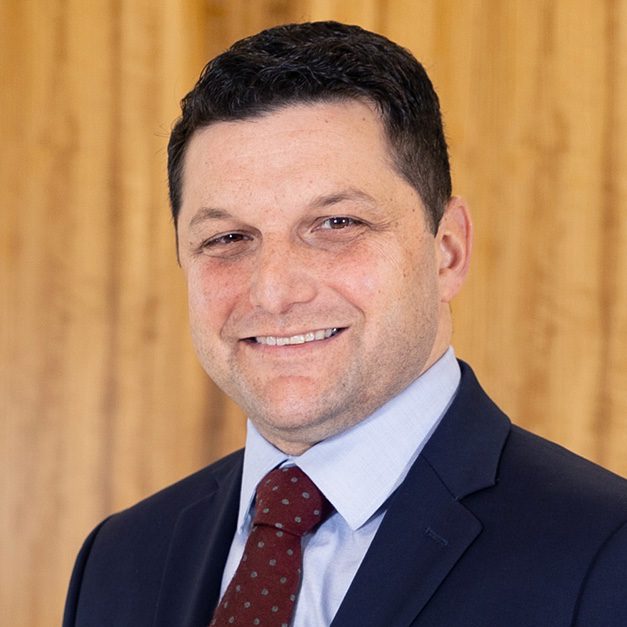For over 10 years, DCS Design has hosted an annual DC Sustainability Summit (DCSS) which aims to inspire and educate the real estate community to be more sustainable at work, home, and play by showcasing pioneering speakers and presenting innovative green products.
At the 2024 DC Sustainability Summit on September 18, 2024, W+A’s Justin Schor and Marie Cox will join our colleagues Jordi Fabian with APAH, Michael Davis with Fairfax County Government, and Scott Adams from McGuireWoods on a panel that addresses “Affordable Housing: How to Build and Operate It More Sustainably”.
While DCSS is focused on the environmental and green components of sustainability, this panel will specifically address how new affordable housing developments can minimize their environmental impact while creating a much-needed affordable housing supply if they are designed, constructed, and operated with careful thought.
Each of the panelists will examine what is required to achieve more sustainable affordable housing from their different professional perspectives, taking into account the economic and social elements of sustainability.
In other words, when developing affordable housing in the Washington, DC region, all three of these elements of sustainability must be considered: environmental, economic, and social.
In the lead-up to this session, we’ve asked the panelists to examine opportunities for economic, social, and environmental sustainability in affordable housing in this Q&A.
Q: Many environmentally sustainable construction strategies cost more than traditional ones. How can housing be constructed affordably and still be environmentally sustainable?
A (Scott E. Adams, McGuireWoods):
There is always a tension between elevated expectations, including environmental sustainability, and being able to build and preserve affordable housing. That tension typically results in a balancing of various priorities. The impact of environmental sustainability commitments plays out differently depending on the project. For dedicated affordable projects using Low-Income Housing Tax Credits (LIHTC), there is typically a financing gap that is made up by local governments or other finance sources. Enhanced expectations for sustainability measures make those financial gaps larger. That can result in additional money supporting fewer units.
That said, there are also green requirements within the state’s Qualified Allocation Plan (QAP) that, if met, can make LIHTC projects more competitive. The balance is typically needed when sustainability expectations exceed what is necessary to make projects competitive under the QAP.
In my view, there should be a recognition that we are facing a housing crisis at the same time we are facing a climate crisis. Anyone that is in a position of approving projects should recognize the need to balance priorities to make sure we are addressing both issues, even if we may not be pushing as far as possible on either one.
“In my view, there should be a recognition that we are facing a housing crisis at the same time we are facing a climate crisis. Anyone that is in a position of approving projects should recognize the need to balance priorities to make sure we are addressing both issues.” – Scott E. Adams, McGuireWoods
Q: How can expensive environmentally sustainable operating systems benefit residents affordable housing project?
A (Jordi Fabian, P.E., Arlington Partnership for Affordable Housing):
Energy insecurity is a growing issue for low-income households. The average American household spends approximately $2,170 per year on home energy costs representing about 3% of their household income. Households that pay more than 6% of their total income are considered to be a “High” energy burden.
Low-income households, 60% of the Area Medium Income (AMI) or below, are disproportionately more likely to be energy-burdened than non-low-income households.
Energy efficiency is a way to tackle the challenges of high energy costs. APAH can implement energy efficiency through new construction or rehab projects.
“Low-income households, 60% of the Area Medium Income (AMI) or below, are disproportionately more likely to be energy burdened than non-low-income households. Energy efficiency is a way to tackle the challenges of high energy costs.” – Jordi Fabian, P.E., APAH
Low-income housing tax credits as well as other state sources such as Housing Innovations in Energy Efficiency (HIEE) require us to implement and also allow us to fund sustainable improvements for our new construction and rehab developments which ultimately allows for a reduction in energy costs which is an ultimate benefit for our residents.
So how does this work?
These funding sources typically require specific thresholds in sustainability, such as achieving a green building certification and meeting Zero Energy Ready Homes and Energy Star certifications. There is always a premium to achieving sustainability requirements. Without getting into the technicalities many of the building components that come at a premium are windows, HVAC systems, ductwork, lighting, and appliances.
APAH can layer the different available funding sources, allowing us to finance the construction and the implementation of these sustainability components. In addition, sources such as HIEE are one of the many sources that allow us to close the finance gap which is also a common challenge we face in the development of affordable housing. In summary, the net benefit of sustainability in affordable housing is that our residents benefit by paying lower utility bills throughout the cycle of their lease.
Q: What environmental benefits come from the reduction in the amount of parking constructed?
A (Michael Davis, AICP, Parking Program Manager, Fairfax County):
There are no environmental benefits gained from requiring or building more parking than necessary. Reducing the footprint of parking allows more efficient use of developed land areas that can create opportunities for more landscaped and open public spaces. It provides an opportunity to create places for people instead of cars.
Reduced parking requirements decrease the required impervious parking infrastructure. Decreasing impervious surfaces reduces heat island effects. It provides opportunities to convert surface parking to natural planting areas or areas with lower heat retention properties. It also encourages repurposing of surface parking to provide better stormwater management and mitigation infrastructure during development or redevelopment. This reduces nonpoint source pollution which enters our ecosystem through stormwater runoff from surface parking areas. Further, a new parking adjustment option is available that allows a reduction of parking rates below minimum requirements in exchange for the conservation or enhancement of greenspace and tree canopies.
“Reducing the footprint of parking allows more efficient use of developed land area that can create opportunities for more landscaped and open public spaces. It provides an opportunity to create places for people instead of cars.” – Michael Davis, AICP, Fairfax County
A benefit of lower requirements is the opportunity to reduce vehicle emissions, which is a chronic problem in the metropolitan area. Providing less parking reduces induced car trips because drivers will no longer see the availability of ample, free parking as the easiest option for accessing a site or area. Reducing the influence of parking in high-density areas creates opportunities to build compact developments that allow people to travel by non-auto modes to access goods, services, and employment. The creation of a tiered parking framework, which reduces parking rates in densely populated areas and around transit hubs, supports the use of existing and proposed public transportation.
Implementation of bicycle parking minimum requirements and standards encourages the use of this cleaner mode of transportation. The implementation of bicycle parking requirements with safe and convenient places to store bicycles will support non-vehicular travel alternatives.
Q: Are there opportunities after a development is constructed to enhance environmental benefits by reducing the number of cars parked?
A (Marie Cox, TDM-CP, Principal, Wells + Associates):
While we have seen a considerable uptick in electric vehicle ownership in recent years, 82.4% of cars sold in May 2024 were gas-powered. (1) As stated by the EPA, “A typical passenger vehicle emits about 4.6 metric tons of carbon dioxide per year. (2) This number can vary based on a vehicle’s fuel, fuel economy, and the number of miles driven per year.” So every car that can be removed from use at an affordable housing development after it is constructed is likely to reduce carbon dioxide by an average of 4.6 tons annually. Or the equivalent in weight of an Asian elephant per year per car.
To put this into perspective, if you have a building with 150 units and just 5% of those don’t own a vehicle, that’s 7 cars off the road, roughly 6,132 vehicle trips eliminated, and 32 tons of emissions reduced. (3)
Now how do we get there? This can be realized by implementing strategies and amenities that help more people bike, walk, take transit, carpool, or vanpool so they can live their lives without being tied to a vehicle – or transportation demand management.
A great example of this from an affordable housing perspective was during my time with Arlington County, where we were working with an affordable housing building and community center. The residents living there were primarily families from outside of the United States and were concerned about how to get their children to school, as they were at the edge of a walk zone in a traffic-heavy neighborhood. Their survey results also showed they didn’t know how to connect with the transportation resources around them or where to turn. To break down these barriers, we brought these resources to them in a way that made sense for them and made them feel safe.
To do so, we hosted a family-friendly outdoor event in their community where we brought in:
- A mobile commuter store where families signed up for free student bus passes and learned about transit options near their home,
- Capital Bikeshare, which provided cash-based memberships and $5 annual memberships through their Capital Bikeshare for All program,
- A local bicycle shop that provided free tune-ups and empowered youth in the community with bike mechanic skills,
- Community groups that could help residents connect with local programs and also gave them the opportunity to share feedback on bicycle and pedestrian planning to support future planning efforts.
As a result, over 300 people received information or support and more than 50 families received free student bus passes. In future iterations of this event, we brought in more community groups and shut down streets and parking lots, using the space to provide pop-up bike lanes so people could try biking or an e-scooter for the first time in a comfortable space.
Some people will require a vehicle, but the fact is that many people still don’t have access to a car or will share a single vehicle. When we can break down barriers to the use of sustainable transportation and empower people with knowledge and access, we create more sustainable communities, but we also influence better health and economic outcomes for the people we serve.
Notes:
(1) What Is the Percentage of Electric Cars in the U.S.?
(2) Greenhouse Gas Emissions from a Typical Passenger Vehicle
(3) American Driving Survey 2022
Q: How can parking impact the financial viability of an affordable housing project?
A (Jordi Fabian, P.E., Arlington Partnership for Affordable Housing):
Parking is always a significant cost for any new development, especially for a project of the size of Dominion Square (note: now called The Exchange at Spring Hill Station).
When the project started, we were required to meet a 1:1 parking ratio. Our team was able to navigate through the parking reduction process and received approval to reduce the parking requirement from a 1:1 to 0.70 ratio. This essentially reduced a full level of parking, approximately 154 spaces. Essentially, we were able to go from 5 levels to 4 levels below ground. This was a key factor in closing the gap and getting the project to move forward.
“We were able to shave about a month and a half from the project schedule by eliminating a full level. The reduction in the schedule allows for a further reduction in general conditions costs, as well as a reduction in construction interest, and delivering much needed affordable housing faster.” – Jordi Fabian, P.E., APAH
In addition to the savings in hard costs, there are other benefits associated with a parking reduction. For instance, at Dominion Square, we were able to shave about a month and a half from the project schedule by eliminating a full level. The reduction in the schedule allows for a further reduction in general conditions costs, as well as a reduction in construction interest, and delivering much-needed affordable housing faster.
Q: In recent years, Fairfax County has made a concerted effort to help reduce the amount of parking that new developments need to construct. How has Fairfax County’s “Parking Reimagined” initiative examined parking requirements for affordable housing?
A (Michael Davis, AICP, Parking Program Manager, Fairfax County):
Creating opportunities for more affordable housing options is a critical goal of the county. Minimum parking requirements play a role in limiting these opportunities. The cost of providing unnecessary parking has a direct effect on the cost of construction and the ability to provide affordable housing.
For every required parking space, additional capital is needed to fund this development cost which translates to higher rents and purchase prices for housing. Further, dedicating land and structures to unnecessary parking can limit the ability to construct more housing in general (and part of the affordable housing problem is an overall housing supply problem).
Parking research indicates that low-income households, first-time home buyers, disabled people, young adults, single parents, and older people need affordable housing options the most. These are also the groups that generally own fewer autos and are therefore more likely to pay for parking they do not need through higher rents and purchase costs.
Panelists:
 Jordi Fabian, Project Manager with Arlington Partnership for Affordable Housing (APAH), will provide the affordable housing perspective and talk about the HIEE elements that go into constructing and operating affordable housing with greater energy efficiency.
Jordi Fabian, Project Manager with Arlington Partnership for Affordable Housing (APAH), will provide the affordable housing perspective and talk about the HIEE elements that go into constructing and operating affordable housing with greater energy efficiency.
Marie Cox, Principal with Wells + Associates (W+A), will explain how TDM can be leveraged as a means to reduce mobile emissions as well as reduce the number of cars needing to park on site and thereby reduce the amount of parking that needs to be constructed and reduce emissions from concrete production.
 Michael Davis, AICP, Parking Program Manager with Fairfax County Land Development Services, will explain how Parking Reimagined updated Fairfax County’s parking regulations for a more sustainable approach to parking and affordable housing.
Michael Davis, AICP, Parking Program Manager with Fairfax County Land Development Services, will explain how Parking Reimagined updated Fairfax County’s parking regulations for a more sustainable approach to parking and affordable housing.
Scott Adams, Land Use Practice Lead with McGuireWoods, will provide a legal perspective about the policy challenges facing affordable housing projects, including parking requirements that encourage driving and discourage the use of more sustainable transportation choices.
Justin Schor, Vice President of Business Development with W+A, will moderate the panel.




